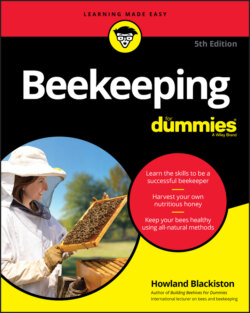Читать книгу Beekeeping For Dummies - Howland Blackiston - Страница 64
The woeful drone
ОглавлениеThis brings us to the drone, the male bee in the colony. Drones make up a relatively small percentage of the hive’s total population. At the peak of the season, their numbers may be only in the hundreds. You rarely find more than a thousand.
New beekeepers often mistake a drone for the queen, because he is larger and stouter than a worker bee. But his shape is in fact more like a barrel (the queen’s shape is thinner, more delicate, and tapered). The drone’s eyes are huge and seem to cover his entire head. He doesn’t forage for food from flowers — he has no pollen baskets. He doesn’t help with the building of comb — he has no wax-producing glands. Nor can he help defend the hive — he has no stinger. He is not the queen or a worker — merely the drone.
The drone gets a bad rap in many bee books. Described as lazy, glutinous, and incapable of caring for himself, you might even begin wondering what he’s good for.
He mates! Procreation is the drone’s primary purpose in life. Despite their high maintenance (they must be fed and cared for by the worker bees), drones are tolerated and allowed to remain in the hive because they are needed to mate with a new virgin queen from another colony (when the old queen from that other colony dies or needs to be superseded). Mating occurs outside of the hive in mid-flight, 200 to 300 feet in the air. This location is known as the “Drone Congregation Area,” and it can be a mile or more away from the hive. The drone’s big eyes come in handy for spotting virgin queens who are taking their nuptial flights.
The few drones that do get a chance to mate are in for a sobering surprise. They die after mating! That’s because their sex organ fits something like a key into a lock so they can effectively discharge their sperm into the queen.The queen will mate with several drones during her nuptial flight. After mating with the queen, the drone’s most personal apparatus and a significant part of its internal anatomy is torn away, and it falls to its death, a fact that prompts empathetic groans from the men in my lectures and some unsympathetic cheers from a few women.
Once the weather gets cooler and the mating season comes to a close, the workers do not tolerate having drones around. After all, those fellows have big appetites and would consume a tremendous amount of food during the perilous winter months. So in cooler climates at the end of the nectar-producing season, the worker bees systematically expel the drones from the hive. Drones are literally tossed out the door. For those beekeepers who live in areas that experience cold winters, this is your signal that the beekeeping season is over for the year.
Depending on where you live, the calendar of events for you and your bees varies depending on temperature ranges and the time of year. To read more about the beekeeper’s calendar in your part of the world, see the information and chart in Chapter 9.
